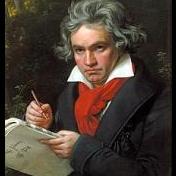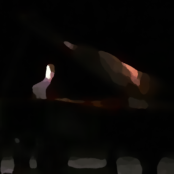Leaderboard
Popular Content
Showing content with the highest reputation on 07/14/2021 in all areas
-
The Ballade in E-flat minor was written in 2021. Though it is written for solo piano, I had intended to write it for piano and orchestra, and may make a version of it for this ensemble in the future. The piece is about 8 minutes long. I hope you all enjoy it 🙂1 point
-
(I'm surprised my account still works - the site looks somewhat different now) Revision of an old (non-Baroque) scholastic fugue of mine written originally for unspecified instruments. The subject (what you can hear in the first 4 measures) was given; I worked it out in four parts, with one single invertible countersubject.1 point
-
Hello guys, I think I’ve finally written a complete theme. However I’ve been struggeling the last few days. This is because I am totally lost where I want to go from here. Any ideas would be highly appreciated.1 point
-
Good evening everyone, I had the good fortune of having my piano tuned for the first time in well over a year a couple of days ago. I'd almost forgotten how nice it could sound and feel! Anyways, given the wild hot/cold weather we've been having here it'll probably only last a week before keys start sticking and the action starts creaking again, so I thought I'd better take advantage of this little window of piano bliss. Here's a link to a collection of five piano character pieces. Written in late 2019, it's my most recent work, and actually the only thing I've written in the past four years or so. As one would expect from the title, these are melody-oriented and not formally complex. Hope you enjoy!1 point
-
So, I have made some significant progress in composing my Romantic Dance Suite that I mentioned here: A little of this progress is in the Polonaise, but most of the progress I have made is in the second dance, the Mazurka, of which I wrote down 40 bars in 1 hour. That's like the fastest I've ever composed a piece. Even my Minuet, another short dance, wasn't that fast in composition rate. So far I have this structure: A |: B A : | of a piece that I think will end up in this structure: A |: B A : | |: C A : | a simple Rondo Form typical of short Rondos and Rondo form pieces. Even my A section can be broken down into 2 periods and 4 phrases, like this: If I do a Double, as I am considering doing(I would consider doing it for the Waltz too, but I'm not there yet), that would mean most likely Mazurka II being in the parallel minor, which means that the C section of Mazurka I probably shouldn't be in the parallel minor. I just feel that it needs the minor key contrast though. I guess the relative minor or the mediant minor will do. Or maybe the chromatic mediant of F# minor? I'm unsure which minor key to go with, just that I want a minor key contrast other than the parallel minor for the C section, as the Double would be in the parallel minor. I know what a Double is, it's a second dance, usually Baroque, that develops the same melodic material in a different way, the 2 most common Doubles I have seen are that of Diminution(Polonaise of Orchestral Suite no. 2 in B minor) and Parallel Minor(Bouree of Cello Suite no. 3 in G major). Anyway, what do you think of my Mazurka thus far? And what about the key for the C section? As I said before, I'm unsure which minor key to have the C section in. How well do I do that V7/V -> V7 -> I move in Bar 24? Anything I can improve about that V7/V -> V7 -> I motion in Bar 24 or other parts of the Mazurka thus far(I'm thinking of adding some staccato in the dotted rhythms)? Does it feel as though the accent is on the weak beats, because that's important in distinguishing a Mazurka from a Waltz is the accent on weak beats? I will add dynamics later on, they always come after the notes and articulations in my compositional process.1 point
-
These two piano pieces were created by me back in 2014. They are some of the first pieces that have a very simple harmony, yet sound quite natural and competent. Especially in the re-recorded version, which is presented in this video.1 point
-
Incredibly beautiful, very enjoyable pieces and very well composed! I specially like the dedication, since most of my last pieces have been dedications to someone I really love. Thank you for sharing!1 point
-
Hello, Fuge a3 in c minor written for organ. North german style. Please tell me what you think.1 point
-
1 point
-
This is a very nice piece, it makes me want to try to dance to it lol. It reminds me very of Astor Piazzolla!1 point
-
1 point
-
Hello everyone. I have felt that I should start taking the time to post some of my music on YouTube, so here is a set of four short poems for piano. Feel free to have a listen!1 point
-
1 point
-
This is a great piece of music, and very stylistic of the tome with two voices and lute. The counterpoint looks and sounds great as well! This a very beautiful work!1 point
-
I have noticed over time, as I arrange more pieces by more composers, the ease of said arrangements varies wildly from composer to composer and even within the same composer. But, at the same time, I see enough consistency to put composers into specific Arrangement Difficulty categories from the Easy to the Super Hard. I sometimes get the crave to arrange a piece by a composer. Sometimes it’s because it’s one of my favorites from said composer like Mozart and Horn Concerto no. 2. Sometimes it’s out of curiosity or just to see if I can do it like the 1 time I tried arranging a Bach piece and let’s just say that it didn’t turn out well. And sometimes it’s because I want to learn a piece, but can’t find an arrangement of the full piece (this is particularly true for piano arrangements). Composers from vastly different eras end up in the same difficulty and likewise, composers from the same era end up in completely different difficulties. Here are the composers I have arranged and some that I might arrange, sorted by Arrangement Difficulty. Easy These are the ones that I can arrange fast, sometimes within hours, and are easy to arrange for just about any ensemble balanced in registers with minimal tweaking. 2 of these are from the Classical Era and others from eras before and after. These include: Known Haydn Easiest of any composer thus far to arrange Mozart Almost, but not quite as easy as Haydn. Sometimes I actually have to add notes to Mozart and Haydn rather than the subtraction I have to do with Beethoven when arranging. Debussy Despite the more adventurous harmonies, I find it easier to arrange than say Chopin. Tchaikovsky Despite the large orchestra in some of his works, I can always reduce it to piano very easily as there’s a lot of doubling. Estimated None Medium These are the ones for which I need to do more tweaking, but I still find relatively easy to arrange, takes just a little bit more time to do the arrangement. And this is where the ensemble really starts to make a difference in the time. Known Chopin Not as easy to arrange as Mozart, especially those cadenzas, but still not that hard. Vivaldi Relatively easy to arrange for duet, haven’t bothered with other ensembles yet. Estimated Handel Mendelssohn Schubert Pachelbel Brahms <- Despite a style similar to Beethoven, I think it would be easier for me to arrange Brahms than it is for me to arrange Beethoven. Hard These are the ones for which I need to make significant changes to make it work, while still trying to keep the harmonic and melodic integrity of the piece in question. Example, a cluster chord shows up in the left hand under the right hand playing a more normal chord and I have to fit a 9 note chord into a quartet, can’t do it, I have to distill the chord to its harmonic backbone. Or another example, a long sustained 4 note chord shows up and the left hand is still playing the bass line underneath it, I have to turn the chord into an arpeggio(by the way, these examples are from the same arrangement I did a couple years back, that F minor sonata by Beethoven I arranged for a string quartet, which among other Beethoven arrangements brings Beethoven into the Hard zone). Known Beethoven My favorite composer of all time, and the hardest so far that I have arranged, very few easy arrangements. Estimated Liszt Rachmaninoff Mahler Paganini Shostakovich Mussorgsky Bach Super Hard These are the ones that are so complex(like more complex than Beethoven or Liszt) and/or dissonant(Secundal chords, polychords, etc.) that I couldn’t even imagine doing an arrangement of one of their pieces. They are all Modern Era/Impressionist Known None Estimated Holst Stravinsky Ravel Satie Prokofiev Schoenberg Sorry if I made any mistakes spelling the names of some of these composers, I tried to minimize them.1 point
-
1 point
-
1 point
-
Uh, that is basically what I composed here with a few melodic and harmonic alterations: Why would you be plagiarizing my work, without even saying that my work inspired you to write it? I mean, it's not as much of a big deal because I'm expanding the Weather Music Suite that that piece was part of to a full orchestra, but still, it feels wrong that I'm not credited.1 point
-
You could improve it by not copying the melody of Chopin's first mazurka note-by-note.1 point
-
1 point
-
You've got the right idea, but I'll go through the basic procedure below anyway. Your main issue is your counterpoint. You need to learn basic two-part counterpoint, including double-counterpoint, if you're going to be writing canons. For a crab canon, start off simple: 8 bars, 4/4, in C major, canon at the octave, one whole note per bar. And use only diatonic notes for your first practice tries. There is no proposta and risposta, since both voices enter at the same time. Yes, that will be boring, but it's better to learn the procedure first. In the treble clef: put a C4 whole note in the first and last bar. In the bass clef: put a C3 while note in the first and last bar. Now you have just the 6 bars to fill in. Overall, the procedure is to write from both ends—in both voices—with every note decision you make. So... Choose (and notate) a note for bar 2 in the treble clef. If you chose, say, an F4, then after notating that, you'd also notate an F3 in bar 7 of the bass clef, since that provides the necessary retrograde movement. Next choose and notate (in bass clef) a consonant to the F4 in bar 2. If you chose contrary motion for an A2, then after notating that, you'd also notate an A3 in bar 7 of the treble clef. You just carry out this procedure from there until everything meets in the middle. You can now elaborate those whole notes—conservatively, in several passes—using adequate voice leading technique. It goes without saying that the rhythms also must occur in retrograde. From this basis you can gradually write more elaborately with each new canon. If later you want to be able to write the canon on a single line, it has to be a canon at the unison, and you still need to composer it on two staves. After that's all squared away, you can write it on a single staff with a backwards treble clef at the end.1 point





.thumb.jpg.c0a72d70ca19ec34c5702ec7e7951f37.jpg)
.thumb.png.8b5b433a341551e913a34392660bc95b.png)
